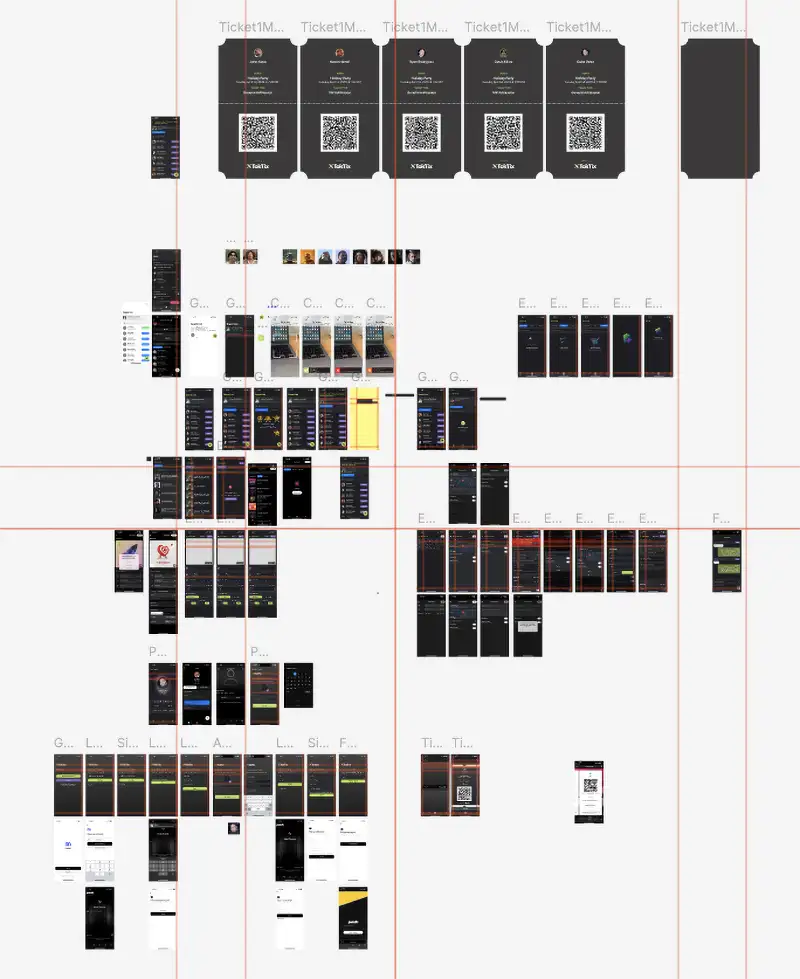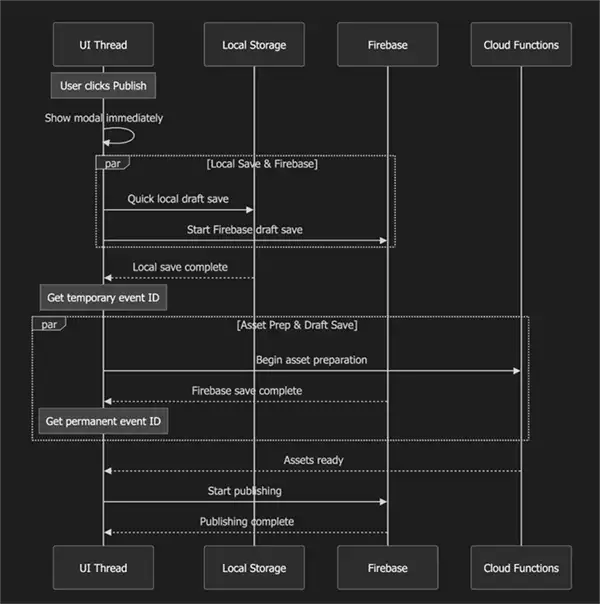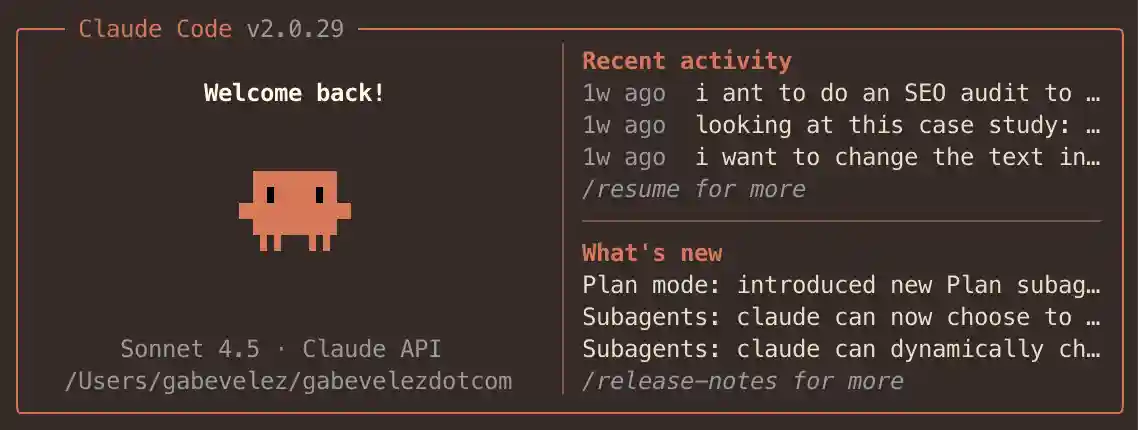The Origin Story
For a while, I've been working with an event company, A&N Online Marketing, and we've always had to deal with ticketing services, running multiple gateways through different companies to handle ticketing. At a time, I was actually hired on the side to work for a young nightlife promoter to help them with their 18 and over events as far as scanning tickets and to get them inside. Due to my past experience with nightlife as a promoter and a designer in my youth, I decided why not do this for nostalgia and fun.
So I would end up working and actually seeing how the ticketing technology had changed over the years. Specifically, how they would bring their own digital tickets to be scanned. I would end up using different applications like Posh.vip and Markit, and while using them thought, "Hey, what if I could build something like this?"
Before, this wasn't a question because it was harder to do because of my lack of certain technical skills. But through the advent now of AI, I said, "Maybe this is a possibility." So I ended up playing with ChatGPT and put together a simple React Native ticket scanning MVP. Showed this MVP to the young promoter, and he was saying, "Oh, this is even better than what we use."
The Spark
That validation moment was the catalyst. Here I was, seeing firsthand the pain points in existing ticketing platforms - the complexity, the bloated interfaces, the friction in both setup and user experience - and realizing that with AI assistance, I could actually build something better.
Then I started playing with some OCR and some AI tools to try to create some sort of flyer extraction setup. At this time, I then moved on to using Claude for my coding. Playing with Expo Go at first for testing the app on my phone. So then I decided, why don't I actually start building a ticketing application? Now it seems with AI, this could be a thing to do.
OCR prototype showing flyer information extraction.
Summary
TokTix demonstrates comprehensive solo product development capability from initial concept through beta launch. Currently in beta testing with 25 users, the platform showcases full-stack mobile and web development expertise enhanced by modern AI-assisted development workflows. Actively developing advanced AI OCR features to differentiate from established ticketing platforms.
- Technical Scope: React Native mobile app, Next.js web platform, Firebase backend with real-time features and Stripe integration
- Current Status: Beta launched August 2025 with 25 active testers, developing enhanced AI OCR flyer extraction to differentiate from market competitors
- Architecture Design: Cross-platform service architecture with clean separation of concerns preventing typical solo project technical debt
- UX Philosophy: "Sleek and simple" design approach prioritizing core user flows over feature bloat, competing with established platforms like Posh, Luma, and Dice
- Solo Development: Complete product lifecycle management including market research, technical architecture, mobile development, web platform, and deployment infrastructure
- Modern AI-Assisted Workflow: Leveraging Claude Code, Claude Projects, and AI coding assistants to accelerate development while maintaining code quality
Context
TokTix represents a complete end-to-end product development challenge: building a modern ticketing platform from concept to beta-ready deployment. What makes this project unique is how it emerged from real-world experience with the pain points of existing ticketing solutions, combined with the new possibilities that AI-assisted development has opened up.
As a solo developer with direct industry experience through A&N Online Marketing and hands-on nightlife promotion work, I took on the full scope of product development including market research, UX design, mobile app development, web platform creation, backend architecture, and deployment infrastructure.
The project targets the nightlife event management market, where existing platforms like Posh, Luma, and Dice have adopted feature-heavy approaches that often overwhelm users. My goal was to prove that a single developer could architect and build a competitive platform by focusing on strategic simplicity and technical excellence, enabled by modern AI development tools.
The technical scope includes:
- React Native mobile application with offline capabilities
- Cross-domain web platform with Next.js
- Firebase backend with real-time features
- Stripe integration for payments
- Multi-tier ticketing system
- QR code scanning and verification
- Image optimization and processing
The Challenge
Building a production-ready ticketing platform as a solo developer presents unique challenges that stretch across multiple domains of expertise:
Technical Architecture Complexity
The platform requires seamless integration between mobile and web experiences, real-time data synchronization, secure payment processing, and offline functionality for ticket scanning. Managing this complexity while maintaining code quality and security standards demands careful architectural planning and execution.
UX Design Philosophy
Competing platforms suffer from feature bloat that complicates core user flows. The challenge was designing an interface that maintains simplicity while supporting complex behind-the-scenes functionality like multi-tier ticket management, event publishing workflows, and cross-platform authentication.
Full-Stack Development Scope
As the sole developer, I needed to master and implement:
- Mobile app development with React Native and Expo
- Modern web development with Next.js and TypeScript
- Backend architecture with Firebase and Cloud Functions
- Payment processing integration with Stripe Connect
- Image processing and optimization systems
- Real-time database design and security rules
- Cross-domain authentication and session management
Solution
My approach centered on strategic technology choices and architectural decisions that would maximize development efficiency while building a scalable, maintainable platform.
Architecture Strategy
I designed a dual-platform architecture that separates concerns while maintaining integration:
Mobile App (React Native + Expo):
- Event creation and management
- Ticket scanning and verification
- Real-time analytics dashboard
- Offline-capable operations
Web Platform (Next.js + TypeScript):
- Event landing pages (events.toktix.com)
- Checkout and payment processing
- Marketing site (toktix.com)
- SEO-optimized event discovery
Backend Infrastructure (Firebase):
- Authentication and user management
- Real-time database with Firestore
- Cloud Functions for business logic
- Image storage and optimization
- Stripe Connect integration

A lot of mobile design via Figma
Service Architecture Design
To prevent the technical debt that typically accumulates in solo projects, I implemented a clean service architecture with clear separation of concerns:
- Event Management Service: Handles event CRUD operations and validation
- Publishing Service: Manages the draft-to-published workflow with error handling
- Image Processing Service: Optimizes and processes event images
- Ticket System Service: Manages multi-tier ticketing and inventory
- Authentication Service: Handles cross-platform user sessions
- Payment Service: Integrates Stripe Connect for promoter payouts
This modular approach prevents circular dependencies and enables independent testing and maintenance of each system component.

Diagraming the mobile authentication userflow.
Cross-Domain Web Architecture
One of the most complex challenges was implementing a cross-domain setup that provides optimal user experience while maintaining technical flexibility:
- toktix.com: Marketing site with contact forms and brand presence
- events.toktix.com: Event-specific landing pages and checkout system
The architecture includes browser-specific handling for Safari to prevent redirect loops, shared authentication across domains, and optimized page generation for SEO performance.
UX Design Philosophy
I adopted a "sleek and simple" design philosophy that prioritizes core user flows over feature abundance:
For Event Promoters:
- Event creation streamlined to under 2 minutes for basic setup
- Draft system allows refinement before publishing
- Multi-tier ticket management without complexity overhead
- Real-time sales tracking with clear analytics
For Ticket Buyers:
- Single-page event discovery with immediate purchase capability
- Checkout process optimized for mobile-first experience
- Clear ticket information without unnecessary steps
- Instant ticket delivery with QR codes for entry
Technical Implementation Highlights
React Native Mobile Development: Built using Expo for rapid development and deployment flexibility. Implemented offline-capable ticket scanning, real-time Firestore listeners for live updates, and custom navigation flows that maintain state across complex user journeys.
Firebase Integration Strategy: Chose Firebase for cost-efficient scaling and built-in real-time capabilities. Implemented comprehensive security rules, optimized Firestore queries for performance, and designed data models that support complex ticketing scenarios while maintaining query efficiency.
Publishing System with Error Recovery: Developed a robust publishing system that handles image optimization, data validation, and error recovery. The system includes progress tracking, exponential backoff retry logic, and clear user feedback throughout the publishing process.

Event publishing workflow with draft system, validation, and error recovery.
Payment Processing Integration: Integrated Stripe Connect to enable direct payouts to event promoters while maintaining platform transaction visibility. Implemented secure webhook handling and comprehensive error management for payment failures.
AI-Assisted Development Journey
The development journey became a fascinating exploration of AI-assisted coding tools and workflows, evolving as I learned what worked best for this project:
Claude Projects Era: During this time I ended up using Claude Projects, which became like another Git repo for all my code, so it can understand all the code together. This was my first experience with AI that could maintain context across an entire codebase.

Claude Desktop Project.
Transition to Cline: Then I moved into using the Cline extension on VSCode and just using Anthropic API keys, which gave me more control over the development environment while maintaining the AI assistance.
The Cursor Experiment: Then moved into Cursor, which actually somewhat massacred my frontend at the time. This was a valuable lesson in tool selection and the importance of understanding how different AI coding tools approach code modification.
Back to Cline: Then moving back to Cline using again using the Anthropic API keys using Claude, burning through tokens as I go. But the results were worth it - I now have a React Native application, which creates Next.js landing pages that get made through the app.
Claude Code Era: Moving to Claude Code has been an incredible experience. I've been able to really 10x my entire production and move a whole lot faster than ever before. My workflow has completely changed using GitHub issues as my issue setup as well as having a memory bank backend to support it as far as memory and to utilize MCPs to do things that quite honestly would take so long to accomplish otherwise.

Claude Code time is here.
Development Workflow and Tooling
Established a comprehensive solo development workflow enhanced by AI assistance:
- TypeScript throughout for type safety and developer experience
- Comprehensive documentation in markdown format for future reference
- Service architecture that enables independent testing and maintenance
- AI-assisted code generation with human oversight and validation
- Performance monitoring and optimization tracking
Results
TokTix demonstrates comprehensive solo product development capability from initial concept through beta launch. Launched in August 2025, the platform is currently in beta testing with 25 active users while continuing to develop advanced AI OCR features for market differentiation. The platform successfully integrates complex technical requirements while maintaining the simplified user experience that differentiates it from competitor platforms.
Toktix homepage hero AI video
Technical Achievements
The platform represents a complete modern development stack implementation:
- Cross-platform mobile application with offline capabilities
- Responsive web platform with SEO optimization
- Real-time backend infrastructure with security compliance
- Payment processing integration with automated promoter payouts
- Image optimization and processing pipeline
- Comprehensive error handling and recovery systems
Architectural Success
The service-based architecture prevents common solo development pitfalls:
- Clear separation of concerns enables independent feature development
- Modular design supports testing and maintenance without team overhead
- Scalable infrastructure design accommodates growth from beta to production
- TypeScript implementation ensures code quality and developer experience
AI-Assisted Development Validation
The project validates the potential of AI-assisted solo development:
- Strategic AI tool usage accelerated development without sacrificing quality
- Proper tool selection and workflow management enabled complex feature implementation
- AI assistance scaled individual developer capability to team-level output
- Documented workflows can be replicated for future projects
Development Workflow Validation
The project validates sustainable solo development practices:
- Comprehensive documentation enables efficient feature iteration
- Automated testing strategies catch issues without manual oversight
- Strategic technology choices maximize development velocity
- Clean architecture patterns support long-term maintainability

Loyout from the Pitch Deck - ask for access :)
Platform Status & Next Steps
TokTix launched in beta in August 2025 and is currently being tested by 25 users in production. The platform demonstrates production-ready quality across mobile applications, web infrastructure, and backend systems.
The project showcases the ability to independently architect, develop, and deploy complex software systems while maintaining high standards for user experience, code quality, and technical excellence.
Currently in active development to enhance the platform's AI OCR flyer extraction capabilities, creating a more robust and differentiated feature set compared to established competitors like Posh, Luma, and Dice. This next phase focuses on building proprietary technology that will set TokTix apart in the event ticketing market.

